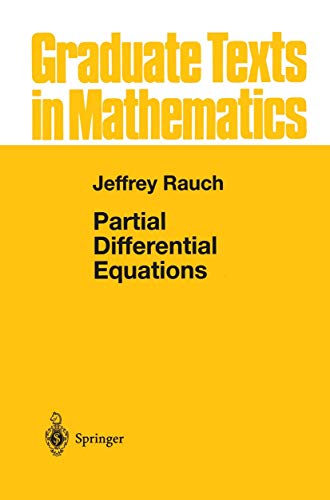Verwandte Artikel zu Partial Differential Equations: 128 (Graduate Texts...

Inhaltsangabe
This book is based on a course I have given five times at the University of Michigan, beginning in 1973. The aim is to present an introduction to a sampling of ideas, phenomena, and methods from the subject of partial differential equations that can be presented in one semester and requires no previous knowledge of differential equations. The problems, with hints and discussion, form an important and integral part of the course. In our department, students with a variety of specialties-notably differen tial geometry, numerical analysis, mathematical physics, complex analysis, physics, and partial differential equations-have a need for such a course. The goal of a one-term course forces the omission of many topics. Everyone, including me, can find fault with the selections that I have made. One of the things that makes partial differential equations difficult to learn is that it uses a wide variety of tools. In a short course, there is no time for the leisurely development of background material. Consequently, I suppose that the reader is trained in advanced calculus, real analysis, the rudiments of complex analysis, and the language offunctional analysis. Such a background is not unusual for the students mentioned above. Students missing one of the "essentials" can usually catch up simultaneously. A more difficult problem is what to do about the Theory of Distributions.
Die Inhaltsangabe kann sich auf eine andere Ausgabe dieses Titels beziehen.
Críticas
"...this is an outstanding text presenting a healthy challenge not only to students but also to teachers used to more traditional or more pedestrian developments of the subject.--MATHEMATICAL REVIEWS
Reseña del editor
This book is based on a course I have given five times at the University of Michigan, beginning in 1973. The aim is to present an introduction to a sampling of ideas, phenomena, and methods from the subject of partial differential equations that can be presented in one semester and requires no previous knowledge of differential equations. The problems, with hints and discussion, form an important and integral part of the course. In our department, students with a variety of specialties-notably differen tial geometry, numerical analysis, mathematical physics, complex analysis, physics, and partial differential equations-have a need for such a course. The goal of a one-term course forces the omission of many topics. Everyone, including me, can find fault with the selections that I have made. One of the things that makes partial differential equations difficult to learn is that it uses a wide variety of tools. In a short course, there is no time for the leisurely development of background material. Consequently, I suppose that the reader is trained in advanced calculus, real analysis, the rudiments of complex analysis, and the language offunctional analysis. Such a background is not unusual for the students mentioned above. Students missing one of the "essentials" can usually catch up simultaneously. A more difficult problem is what to do about the Theory of Distributions.
„Über diesen Titel“ kann sich auf eine andere Ausgabe dieses Titels beziehen.
EUR 3,40 für den Versand innerhalb von/der USA
Versandziele, Kosten & DauerNeu kaufen
Diesen Artikel anzeigenEUR 3,66 für den Versand innerhalb von/der USA
Versandziele, Kosten & DauerSuchergebnisse für Partial Differential Equations: 128 (Graduate Texts...
Partial Differential Equations (Graduate Texts in Mathematics)
Anbieter: Books From California, Simi Valley, CA, USA
Hardcover. Zustand: Very Good. Bestandsnummer des Verkäufers mon0003865104
Anzahl: 2 verfügbar
Partial Differential Equations
Anbieter: ThriftBooks-Atlanta, AUSTELL, GA, USA
Hardcover. Zustand: Good. No Jacket. Missing dust jacket; Pages can have notes/highlighting. Spine may show signs of wear. ~ ThriftBooks: Read More, Spend Less 1.2. Bestandsnummer des Verkäufers G0387974725I3N01
Anzahl: 1 verfügbar
Partial Differential Equations
Anbieter: COLLINS BOOKS, Seattle, WA, USA
Hardcover. Zustand: Very Good. 1st edition. 263pp, octavo, tight binding, clean throughout, mild spine fade, light corner wear, light soiling to back cover. Graduate Texts in Mathematics 128. Bestandsnummer des Verkäufers 159003
Anzahl: 1 verfügbar
Partial Differential Equations
Anbieter: Anybook.com, Lincoln, Vereinigtes Königreich
Zustand: Good. This is an ex-library book and may have the usual library/used-book markings inside.This book has hardback covers. In good all round condition. No dust jacket. Please note the Image in this listing is a stock photo and may not match the covers of the actual item,600grams, ISBN:0387974725. Bestandsnummer des Verkäufers 4136386
Anzahl: 1 verfügbar
Partial Differential Equations (Graduate Texts in Mathematics, 128)
Anbieter: Toscana Books, AUSTIN, TX, USA
Hardcover. Zustand: new. Excellent Condition.Excels in customer satisfaction, prompt replies, and quality checks. Bestandsnummer des Verkäufers Scanned0387974725
Anzahl: 1 verfügbar
Partial Differential Equations (Graduate Texts in Mathematics, 128)
Anbieter: Best Price, Torrance, CA, USA
Zustand: New. SUPER FAST SHIPPING. Bestandsnummer des Verkäufers 9780387974729
Anzahl: 2 verfügbar
Partial Differential Equations
Anbieter: GreatBookPrices, Columbia, MD, USA
Zustand: New. Bestandsnummer des Verkäufers 1998864-n
Anzahl: Mehr als 20 verfügbar
Partial Differential Equations (Graduate Texts in Mathematics, 128)
Anbieter: Lucky's Textbooks, Dallas, TX, USA
Zustand: New. Bestandsnummer des Verkäufers ABLIING23Feb2215580175048
Anzahl: Mehr als 20 verfügbar
Partial Differential Equations (Graduate Texts in Mathematics, 128)
Anbieter: California Books, Miami, FL, USA
Zustand: New. Bestandsnummer des Verkäufers I-9780387974729
Anzahl: Mehr als 20 verfügbar
Partial Differential Equations
Anbieter: GreatBookPrices, Columbia, MD, USA
Zustand: As New. Unread book in perfect condition. Bestandsnummer des Verkäufers 1998864
Anzahl: Mehr als 20 verfügbar

